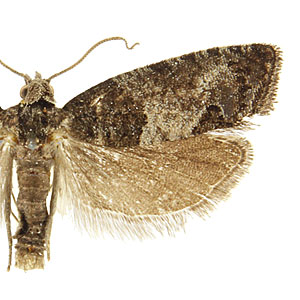Adult Recognition

FWL: 5.5-8.0 mm
Adults are grayish brown and are found in both light and dark forms. Forewing markings include a wide median fasica which ranges in color from white to cream to gray, a dark-brown mark on the dorsum proximal to the tornus, and a series of small black dashes in the ocellus. In many individuals the median fascia is confluent with the postmedian and preterminal fasciae, creating an overall gray or whitish appearance. Males have a notch at the base of the antenna and lack a forewing costal fold.
In North America, S. ocellana is unlikely to be confused with any other species of tortricid. A genitalic dissection can be used to confirm identity of worn specimens. Males have a distinctively shaped cucullus and females have two thornlike signa.
Larval Morphology

Late instar larvae are approximately 9-14 mm long with a gray to dull reddish-brown abdomen. The head and prothoracic shield are reddish-brown to black, sometimes with dark mottling. Prothoracic legs are dark brown. Other distinguishing features include: abdominal pinacula large and raised; SV counts on A1,2,7,8,9 usually 3:3:2:2:2; L pinaculum on A9 trisetose; and anal comb present with 3-8 teeth.
Biology

Spilonota ocellana completes a single generation per year. Adults are present June to August.
Females lay eggs singly on leaves. Newly hatched larvae feed primarily on leaves. Third instar larvae construct a hibernaculum, often in a spur crotch, where they overwinter. Feeding resumes in early spring on fruiting buds, leaves, and blossoms, with larvae forming a tubular chamber between leaves or in a rolled leaf. Pupation occurs in a leaf nest near the feeding site.
Host plants
Spilonota ocellana is a pest in orchards, with apple (Malus) and cherry (Prunus) being preferred hosts.
| Family | Genus/species | Common name |
| Anacardiaceae | Rhus L. | sumac |
| Betulaceae | Alnus glutinosa (L.) Gaertn. | European alder |
| Betulaceae | Alnus japonica (Thunb.) Steud. | Japanese alder |
| Betulaceae | Alnus Mill. | alder |
| Betulaceae | Betula L. | birch |
| Betulaceae | Betula pubescens Ehrh. | downy birch |
| Betulaceae | Carpinus betulus L. | European hornbeam |
| Elaeagnaceae | Hippophae rhamnoides L. | seaberry |
| Ericaceae | Kalmia L. | laurel |
| Euphorbiaceae | Euphorbia paralias L. | sea spurge |
| Fagaceae | Quercus garryana Douglas ex Hook. | Oregon white oak |
| Fagaceae | Quercus robur L. | English oak |
| Fagaceae | Quercus L. | oak |
| Juglandaceae | Juglans L. | walnut |
| Myricaceae | Myrica gale L. | sweetgale |
| Pinaceae | Larix kaempferi (Lamb.) Carriere | Japanese larch |
| Pinaceae | Larix Mill. | larch |
| Polygonaceae | Rumex obtusifolius L. | bitter dock |
| Rosaceae | Chaenomeles speciosa (Sweet) Nakai | flowering quince |
| Rosaceae | Crataegus L. | hawthorn |
| Rosaceae | Crataegus rhipidophylla Gand. | |
| Rosaceae | Cydonia Mill. | cydonia |
| Rosaceae | Malus domestica Borkh. | apple |
| Rosaceae | Malus Mill. | apple |
| Rosaceae | Malus pumila Mill. | paradise apple |
| Rosaceae | Malus sylvestris (L.) Mill. | European crab apple |
| Rosaceae | Prunus L. | |
| Rosaceae | Prunus mume Siebold & Zucc. | Japanese apricot |
| Rosaceae | Prunus pensylvanica L. f. | pin cherry |
| Rosaceae | Prunus persica (L.) Batsch | peach |
| Rosaceae | Prunus salicina Lindl. | Japanese plum |
| Rosaceae | Prunus serrulata var. spontanea (Maxim.) E. H. Wilson | |
| Rosaceae | Pyracantha M. Roem. | firethorn |
| Rosaceae | Pyrus communis L. | common pear |
| Rosaceae | Pyrus L. | pear |
| Rosaceae | Rubus L. | blackberry |
| Rosaceae | Sorbus aucuparia L. | European mountain ash |
| Rosaceae | Sorbus L. | mountain ash |
| Salicaceae | Salix cinerea L. | large gray willow |
| Salicaceae | Salix L. | willow |
Distribution

Spilonota ocellana is present in all apple growing regions of the northern hemisphere. It was introduced into North America from Europe sometime before 1840 and now occurs across southern Canada and the northern United States, ranging as far south as North Carolina, Ohio, and California.
References

Chapman, P. J. and S. E. Lienk. 1971. Tortricid fauna of apple in New York (Lepidoptera: Tortricidae); including an account of apple's occurrence in the state, especially as a naturalized plant. Spec. Publ. Geneva, NY: New York State Agricultural Experiment Station. 122 pp.
Gilligan, T. M., D. J. Wright and L. D. Gibson. 2008. Olethreutine moths of the midwestern United States, an identification guide. Ohio Biological Survey, Columbus, Ohio. 334 pp.
MacKay, M. R. 1959. Larvae of the North American Olethreutidae (Lepidoptera). Canadian Entomologist Supplement 10: 1-338.






